Multifunkciós Sportaréna menekülő lépcsők tervezése
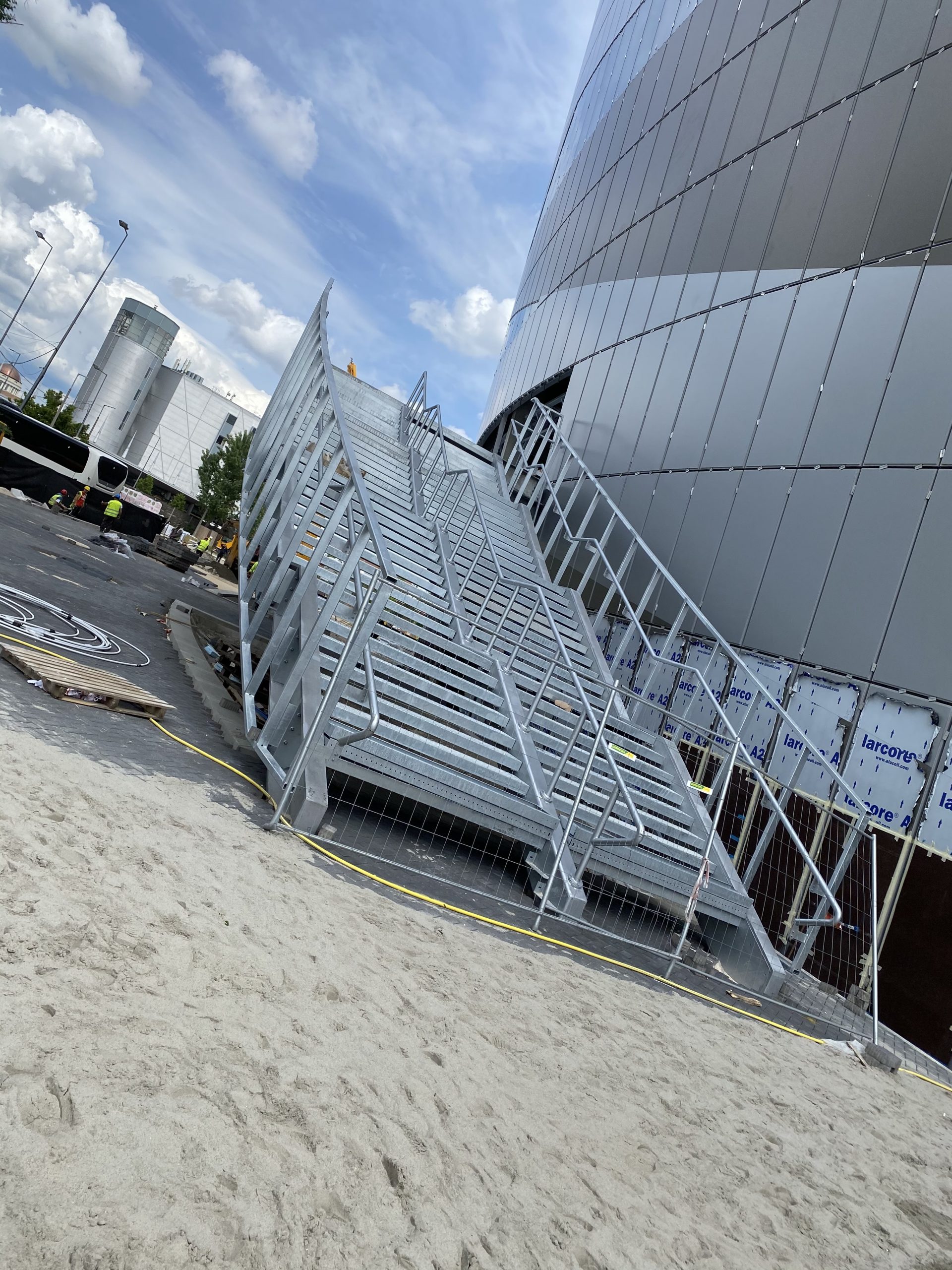
| Kategoria | Projekty użyteczności publicznej |
|---|---|
| Rok | 2021 |
| Kraj | Hungary |
| Organizacja | CEOS Kft. |
| Partnerzy projektu | Market Építő Zrt., Középülettervező Zrt., BIM Design Kft. |
| Autor | Szabó László |
| Współautorzy | Borbély János, Szikszai Zsolt |
| Klient | KKBK |
| Miejsce budowy | Budapest |
| Tags |
Az építmény Európa legnagyobb fedett pályás multicsarnoka, és egyben a legnagyobb hazai projekt 2020-ban. A megközelítőleg ovális alaprajzú épület két tengely mérete a bejárati szinten, megközelítőleg: 135 x 163 m. A számok is impresszívek: 62.905 m3 vasbeton szerkezet, 5.000 tonna acélszerkezet.
A megbízást tárgyát képező acél menekülő lépcsők formatervezése nem szokványos: A Multifunkcionális csarnok ívét, illetve a burkolati mintákat követve kerültek kialakításra
4 példányban készültek melyek közül mind eltérő. 2-2 fő geometriában azonos, de ezeken belül is egymás tükörképei. Egy lépcső hozzávetőlegesen 3 tonnás a járófelület és lépcsőfokok nélkül.
A modellezés kihívásai:
– a szerkezetnek illeszkednie kell az épület homlokzatához annak ívéhez és ferde dőléséhez a lehető legjobban illeszkedve. Ehhez szoros több körös egyeztetésre volt szükség a teljes tervezés során az építészekkel.
– a szerkezet légies hatásának elérése érdekében nagyon kevés felületen támaszkodhatott le a talajra így nagy fesztávokat kellett áthidalni és a megadott szűk keresztmetszeteken belül szerkezetileg kialakítani.
– a szerkezet nagy része látszó és ezért a csomópontok kialakításánál ügyelni kellett azok végleges esztétikus megjelenésére is
– felületkezelés szempontjából a teljes szerkezet horganyzott, ezért a gyártmánytervezés során figyelni kellett ezen technológia korlátaira is.
– a Stephuit N típusú lépcsőfokok és járófelület kialakítás egyedi kapcsolatokat igényelt ahol a tervezés során szoros kapcsolattartásra volt szükség a termék gyártójával és az acélszerkezet gyártással.
– mivel a lépcső előregyártott vasbeton pillérekhez kapcsolódik így gondoskodni kellett a megfelelő állíthatóságról ami a vasbeton szerkezet méret pontatlanságából adódhat itt a kivitelezéssel tartottuk a kapcsolatot mely során helyszíni méréseket kaptunk a pillérek pozíciójáról
– az íves és spirális elemek gyártmányterveken és szerelési terveken történő ábrázolása során a gyártóval folyt egyeztetés, hogy a számukra megfelelően értelmezhető tervek készüljenek.
A tervezési folyamatban a Tekla számos speciális tulajdonságát használtuk:
– a projekt Design&Build jellegéből adódóan a formatervezés együtt haladt a tervezéssel, emiatt sokszor módosítani kellett a modellt, ebben nagy segítségünkre volt a Tekla változás kezelési rendszere.
– számunkra új volt a spirál gerendák használtata, de kifejezetten jól jött a szerkesztés során. Ezen funkció nélkül nem tudtuk volna a kívánt formát kialakítani.
– a tervek készítésénél nagy segítséget nyújtott a megfelelő ábrázolásban az íves metszet funkció ami itt igazán nélkülözhetetlen volt.
The building is the largest indoor multipurpose hall in Europe and the biggest project in Hungary country in 2020. The two axes of the building, which has an oval shape, have the following dimensions at the entrance level: 135 x 163 m. The figures are impressive: 62,905 m3 of reinforced concrete structure, 5,000 tons of steel structure.
The steel escape stairs were made 4 pieces, each of which were different. 2-2 are identical in main geometry, but are mirror images of each other. One staircase weighs approximately 3 tonnes without walkways and treads.
Our task was to design a visual element of unconventional design. Our task was even complicated by the need to adapt to a constantly changing structure under construction in a Design&Build type of project.
The challenges of modelling:
-The structure must fit the building facade, following its curve and slope as closely as possible. It was necessary to consult with the architects throughout the whole design process.
– In order to achieve an airy effect, the structure had very little surface area to rest on the ground, so large spans had to be bridged and structurally solved within the given very limited cross sections.
– Much of the structure is exposed and therefore care had to be taken in the design of the nodes to ensure their final aesthetic appearance
– From a surface treatment point of view, the entire structure is galvanized, so the design of the fabrication had to take into account the limitations of the technology.
– The design of the Stephuit N stair treads and walkway required unique joints, where close liaison with the product manufacturer and the steel structure fabrication was necessary during the design process.
– With the stairs being connected to prefabricated reinforced concrete piers, care had to be taken to ensure proper adjustability, which could result from the dimensional inaccuracy of the reinforced concrete structure. Here, we liaised with the construction company, which provided us with on-site measurements of the position of the pillars
– Due to the special curved and spiral elements the steel manufacturer was consulted to ensure that the drawings were properly interpreted.
A number of Tekla’s special features were used in the design process:
– Due to the Design&Build nature of the project, the design went hand in hand with the architectural design, which meant that the model had to be modified many times, and Tekla’s change management system was a great help.
– The use of spiral beams was new to us, but it came very handy during the detailing process. Without this feature we would not have been able to create the desired shape.
– When creating the plans, the curved section function was a great help in getting the right representation, and was really indispensable here.
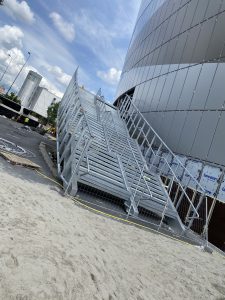
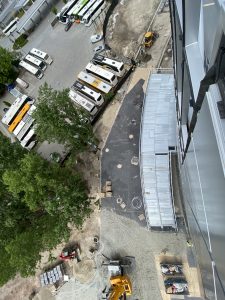

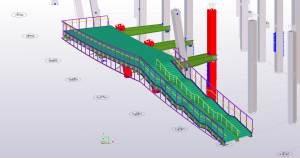



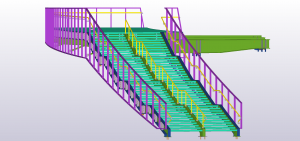

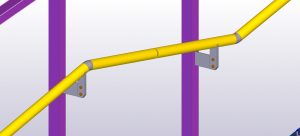

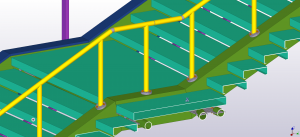


Nice staircase! 😉